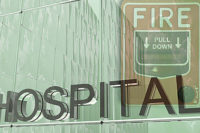Before we get into the status of modern fire suppression and the special risks of solid-fuel cooking, let’s look at several real-world commercial kitchen events and the patterns that emerge.
Privately-owned Italian restaurant. Located on the first floor of an historic building, fire ignited in the exhaust hood and duct over a wood-fired charbroiler, nearly spreading to second-floor hotel rooms before it was extinguished. During restoration, the solid fuel charbroiler was replaced by a gas charbroiler, as encouraged by the owner’s insurance company.
Airport terminal restaurant. Fire ignited at a large metropolitan airport in a restaurant exhaust system over two wood-burning appliances. The conventional fire suppression system detected the fire and actuated the suppression system, but the liquid fire suppressant was not dispersed. The suppressant tank was found full, suggesting system inspection and maintenance issues.
Upscale chain restaurant. An upscale chain of about 40 restaurants experienced charbroiler fires at three locations in the past year. The third fire occurred in a restaurant on the first floor of a large multi-story shopping mall. One wing of the mall was evacuated during the fire, and the restaurant was closed for three months during its restoration.
Restaurant in condo development. Fire ignited for the third time in an exhaust hood and duct of a large restaurant located on the ground floor of a city-block-sized multi-story condominium development. The conventional fire suppression system did not suppress the latest fire, which was contained by the extensive but greatly damaged exhaust system. After this fire, the owner elected to vacate the restaurant space and sell his lease.
Luxury resort hotel. A fire ignited in the exhaust hood and duct of an upscale restaurant on the first floor of a multi-story wing of the hotel. After the chef noticed flames coming out of the exhaust filters, the fire spread through the duct. With smoke emerging from the exhaust outlet on the roof, guests were evacuated from 200 rooms. The charcoal and wood fire was set daily in a brick-lined alcove, but the long duct had never been completely cleaned.
What do these fires have in common? Though the building types and sizes are diverse, all of these restaurants employed solid fuel cooking, exhaust ducts were insufficiently cleaned, and none of the fires were suppressed by conventional fire suppression systems.
CONVENTIONAL FIRE SUPPRESSION SYSTEMS
Conventional fire suppression systems were developed decades ago, with detection by one or more sets of fusible links that were developed nearly a century ago. Sets of links are generally installed above appliances and in duct entrances, per listings. The links are held in tension by a release cable, and when sufficient heat is applied to melt solder holding the links together, the cable slackens and actuates the release mechanism to puncture a gas canister and disperse suppressant to appliances, hood plenum, and lower duct.
The lack of detection and suppression of cooking fires by conventional fire suppression systems, with or without solid fuel cooking, is related to several factors.
-
Over 25 components and sequential actions must be set up and function properly for systems to actuate and properly disperse suppressant.
-
Fires can move upward in hoods and ducts faster than fusible link detectors can absorb enough heat to separate and actuate systems. For example, fire moving in an exhaust stream at 1,500 ft/minute travels 25 ft/second.
-
Fusible links coated with grease and other exhaust products can delay or preclude actuation.
-
Some fires ignite above the specified locations of fusible links over appliances and in duct entrances, and placement of these detectors higher in ducts is impractical for duct cleaning and not supported system listings.
-
Conventional fixed-tank systems discharge wet chemical suppressant for about one minute only.
-
The amount of fire suppressant is limited to what’s stored in the fixed tank, and though multiple tanks can be added for long hoods, the dispersion time remains about one minute.
-
Though conventional fire suppression system actions include shutting off gas and electricity to appliances, there is no means of automatically turning off burning solid fuel.
-
Conventional systems are unmonitored, except for a small “armed” flag visible in systems cabinets and required technician checks and tests every six months.
Though suppression system reliability was not the subject of his report, Evarts, in an NFPA report, briefly describes 13 restaurant fires, presumably with conventional cooking and conventional fire suppression systems1. Close reading reveals that fire suppression systems did not operate reliably in five of these 13 cases.
SOLID FUEL COOKING
Close to 4,000 North American chain restaurants and an unknown number of privately owned restaurants have added solid fuel cooking in the past few years. Advertising for these restaurants includes phrases such as "live fire," "wood roasted," and "wood-broiled." In current practice, solid fuel cooking includes use of wood-only; gas cooking with "wood assist;" and charcoal, with or without wood. Appliances used include charbroilers, ovens, smokers, rotisseries, barbecue pits, or a combination of those units.
CREOSOTE FIRE RISK
NFPA 96 section 11.6.2 indicates that hoods, ducts, and fans “shall be cleaned to remove combustible contaminants prior to surfaces becoming heavily contaminated with grease or oily sludge.” The “oily sludge” is likely combustible creosote, which adds to the usual risk of grease fires in hoods, grease filters, ducts, exhaust fans, and pollution control units.
Creosote is well known for its fire threat in chimneys above residential wood-burning fireplaces. From the Cornell Cooperative Extension Service:
“Creosote is made up of condensed volatile gases created by incomplete combustion of the wood. As these gases rise in the chimney, they cool, mix with water vapor, and form a tar-like substance that clings to the chimney walls… Chimney fires can start quickly and be very powerful, shooting flames many feet above the chimney cap and producing a loud rumble like a freight train going by.”2
To adapt this explanation to commercial kitchens, substitute “duct” for “chimney.”
With solid fuel cooking, fire risk is increased because creosote deposits can ignite directly in ducts, above the locations of fusible link detectors. Additionally, creosote has relatively low flash point and auto-ignition temperatures, and it burns robustly.
INCREASED RISK
While many commercial kitchen fires occur in freestanding restaurants, some fires start in restaurants within buildings with multiple tenants and/or multiple stories where the scale of damages and business interruptions can be much higher. For example, a fire occurred last fall in a steakhouse kitchen with gas cooking in a large resort hotel and convention center with nearly 2,900 guest rooms.
A cook left some food cooking unattended, fire ignited, and it was not suppressed by the fire suppression system. The fire spread through the hood and grease filters to a very long duct system from which smoke escaped to areas inside the large building complex. Guests were evacuated and not able to return to their rooms for over 12 hours.
SUPPRESSION IMPROVEMENTS
In response to issues with conventional fire suppression systems, manufacturers are adding features to improve their products. For example, suppression systems from two manufacturers offer optional electronic detection in place of detection with fusible links, but these systems retain fixed amounts of suppressant and limited discharge times.
Another improved system adds unlimited potable water for suppression following actuation and wet chemical agent discharge, though this system continues to use fusible links for detection. This manufacturer also offers an option to monitor whether a propellant cartridge is installed, though it does not verify that the cartridge is new and unused.
One manufacturer has developed an advanced fire suppression system that includes new features and technology to improve significantly on the issues of conventional systems. Features include:
-
Fully electronic detection, operation, monitoring, and communications, with battery backup.
-
Detectors activate from sensing either a set temperature or a significant rate of temperature rise, and detectors are “rate compensated” to minimize false alarms.
-
Detector distance from controls is not limited, so detectors can be placed in upper duct locations in addition to duct entrances and optionally over appliances.
-
Water suppressant dispersion is powered by building water pressure.
-
Liquid surfactant is added to building water to reduce surface tension and improve wetting of fire surfaces.
-
Mist piping and nozzles provide overlapping coverage.
-
Suppressant dispersion time is unlimited, though timers are usually set to minimize water flooding of kitchen areas, such as 30 minutes for duct and plenum, and 15 minutes for appliances.
-
Continuous monitoring is provided with local annunciation and optional communications to building management systems and internet devices.
-
The system can be employed in pollution control units as well as exhaust hoods.
-
Compact system controls, water valves, gauges, surfactant tank and pump, and communication ports are contained in a hood end cabinet or nearby wall cabinet.
-
The system is listed to UL 300 and complies with NFPA 17A.
Importantly with this system, misting nozzles discharge water and surfactant droplets that provide a thermal blanket on fire surfaces and limit surface temperatures to 212°F (at sea level) to quickly eliminate fire spread. Water mist also reduces temperatures of burning surfaces because the energy required to vaporize water is higher than with most other materials.
Additionally, when mist droplets absorb heat from the fire and vaporize, the vapor volume expands to more than 1,000 times the volume of the liquid water. This large increase in water vapor volume displaces air and the oxygen it contains to further suppress combustion. The thermal blanketing, surface cooling, and oxygen displacement features are effective wherever the water and surfactant are sprayed.
The modern suppression system also provides daily cleaning with hot water and surfactant of the hood plenum, backs of filters, lower duct surfaces, and electronic detectors. The system operates automatically after the related exhaust fan is turned off at closing with wash water drained to the kitchen grease trap. Though the aspects are slightly different, comparative photos show hood plenums in two sister restaurants, three months after opening, with and without automated cleaning.
RECOMMENDATIONS
Fire suppression systems. Advanced technology fire suppression systems are highly recommended for all commercial kitchen hoods over solid fuel cooking, and for all commercial kitchens in multi-tenant and multi-story buildings, where the scale of damages and interrupted business is greater. Systems should include electronic detection and operation, battery backup, continuous monitoring, surfactant added to unlimited water mist, overlapping coverage, and communication of alerts and alarms available locally and remotely.
Exhaust ducts. As previously discussed in the author’s article in the January 2015 issue of Engineered Systems (“Issues and Improvements In Commercial Kitchen Exhaust Ducts”): with typical code and standard requirements for grease-laden cooking (Type I hoods) of listed hoods, filters, and exhaust fans, it makes sense to specify listed ducts along with the other listed products.
Listed factory-built ducts are highly recommended for all hoods with solid fuel cooking, as well as in multi-tenant and multi-story buildings, if not all commercial kitchen exhaust systems. Listed (or approved) duct systems are required by NFPA 96 section 14.4.2 for duct systems four stories in height or greater.
Duct cleaning. Reviews of sample restaurant fires in the past few years suggest that duct fires are often paired with that sold fuel cooking. In several cases, ducts were insufficiently cleaned, sometimes due to lack of access, along with other code and standard shortcomings.
NFPA 96 in Table 11.4 requires a monthly inspection of “systems serving solid fuel cooking operation,” although more frequent inspection might be necessary, based on volume of cooking. Note that a prominent fire investigator and author suggests that: "Buildup from solid fuel cooking can create a serious fire hazard in as little as a week."3
Spark arresters. NFPA 96 in section 14.1.6 requires spark arresters for solid fuel cooking, though there are no standard tests or listing requirements for these products. One “spark arrester filter” product cites specifications in NFPA 211, but that standard’s definition is “…a device attached to a chimney termination to prevent the passage of sparks and brands to the outside atmosphere,” which seems to refer to residential chimneys, not commercial cooking appliances and equipment.
Masonry and concrete ovens. Fire protection requirements for this oven category are limited. NFPA 96 indicates that “fixed automatic fire-extinguishing equipment” is not required if the oven is vented in accordance with NFPA 211. Because creosote fires can start directly in ducts, from low flash point and auto-ignition temperatures, and then spread from imperfect welded-on-site ducts, specification of listed ducts for these appliances is highly recommended. ES
References
1. Evarts, Ben. “Structure Fires in Eating and Drinking Establishments.” Appendix B. National Fire Prevention Association (NFPA), 2012
2. Cornell Cooperative Extension – Tompkins County, excerpts from “Wood Stove Safety” at: http://ccetompkins.org/energy/renewable-energy/heating-with-wood/wood-stove-safety
3. Ackland, Phil. "A Guide for Commercial Kitchen Fires." 2012. Philip Ackland Holdings, Ltd. Chapter 5, Page. 5
Biblography
Griffin, Bill and Morgan, Mike. “60 Years of Commercial Kitchen Fire Suppression.” ASHRAE Journal, June 2014
Horton, Doug. “Lessons Learned from Commercial Kitchen Fire Investigations.” ASHRAE Journal, February 2015







